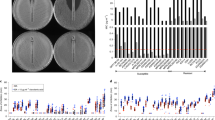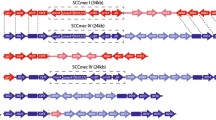Abstract.
Methicillin resistance in staphylococci is due to the acquisition of the mecA gene encoding a new penicillin-binding protein (PBP2′, PBP2a) that has a lower affinity to methicillin than the endogenous PBPs. PBP2′ is involved in the assembly of the cell wall peptidoglycan in the presence of high concentrations of β-lactams that otherwise inhibit the endogenous PBPs. The production of PBP2′ is under dual control by its own mecR1-mecI- and the penicillinase blaR1-blaI-encoded regulatory elements. Resistance to high levels of methicillin depends, in addition to PBP2′, on chromosomally encoded factors that are involved in the synthesis and degradation of the peptidoglycan. Any mutations that reduce peptidoglycan precursor formation or change the chemical composition of the muropeptide precursor result in lowered resistance.
Similar content being viewed by others
Author information
Authors and Affiliations
Rights and permissions
About this article
Cite this article
Berger-Bächi, B. Genetic basis of methicillin resistance in Staphylococcus aureus. CMLS, Cell. Mol. Life Sci. 56, 764–770 (1999). https://doi.org/10.1007/s000180050023
Issue Date:
DOI: https://doi.org/10.1007/s000180050023




